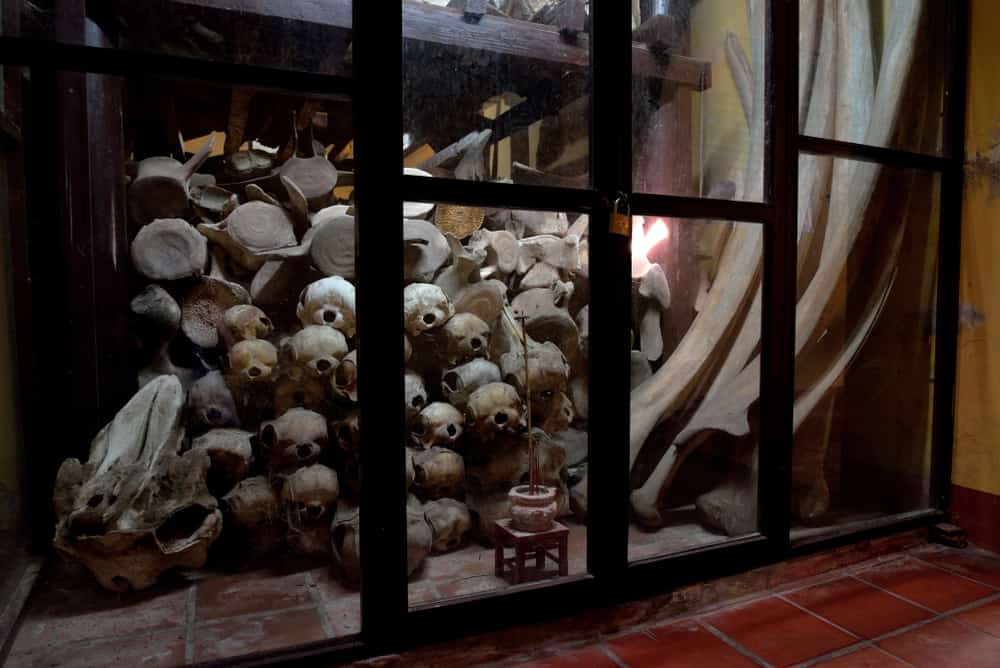The fishing towns along Vietnam’s southern and central coastlines house over 1,000 shrines honoring dead cetaceans, or marine mammals. These places of worship are vitally important to the people in these communities. But scientists are interested in them, too. 65-foot baleen whales encased in glass from centuries past, along with many other preserved marine animals, hold clues to what ocean life was like hundreds of years ago. These ancient whale temples not only offer hope to the local fisherman but also to researchers. Find out what information these skeletons hold and what we can learn from them.
About the Ancient Whale Temples in Vietnam

The Van Thuy Tu Temple is the largest whale temple in Vietnam, housing over 500 whale skeletons, including one 66 feet long on display.
©Anna ART/Shutterstock.com
Thousands of whale temples, shrines, altars, statues, and idols are within a 2,000-mile Vietnamese coastline. These sacred temples differ from the typical. Whale bones and other cetacean bones are around the temples or placed inside. The temples range from large, intricate structures to old, converted fishing boats or simple gravestones. If local fishermen, or others within the community, come across a deceased whale, they will bring it back with them to bury or enshrine it. Some of them are so large they have to use motored boats to pull the carcass ashore.
The Van Thuy Tu Temple is the largest whale temple in Vietnam, housing over 500 whale skeletons, including one 66 feet long on display. Some of the whales are over 100 years old. The temple was built in 1762 and is considered the oldest in the area. Some other notable ancient whale temples include the Lang Ong Nam Hai Temple and the Lang Tan Temple.
Whale Worship: What is the Whale Religion in Vietnam?
Whale worship is a Vietnamese folk religion called Cá Ông. The people in the coastal villages pray and give offerings at whale temples for safe passage. Cá Ông is a whale spirit that blesses them with safe travels and bountiful catches. These fishing communities have been building shrines and temples to worship whales for at least two centuries. Two whales carried an 18th-century warlord to safety during battle. Once he became emperor, he declared whales sacred and ordered his people to worship them as gods.
What is the Purpose of Studying Ancient Whale Bones?

Scientists use these hundred-year-old marine mammal bones to better understand historical diversity and distribution within the region.
©EdithFotografeert/Shutterstock.com
Along with cultural history, these ancient whale temples are a treasure trove of natural history. Many marine mammal researchers lack funding to further their studies, so these Vietnamese temples are extremely useful in their research. Many of the temples don’t just house whales, they also have other cetaceans, such as dolphins and porpoises. Scientists use these hundred-year-old marine mammal bones to better understand historical diversity and distribution within the region. For instance, some species, like the Omura’s whale, did not inhabit the waters near Vietnam. But their bones are in the country’s temples, meaning researchers can add another species to the area’s record.
What Can Scientists Learn from the Bones in the Ancient Whale Temples?

The work these researchers are doing is an excellent example of respecting cultural history while using science to directly benefit the community.
©Anna ART/Shutterstock.com
Scientists can gain much insight into the historical distribution of whale, dolphin, and porpoise species in the area’s waters. They can also discover species that once inhabited the area but are now locally extinct, such as the dugongs. The dugong is a marine mammal and a cousin to the manatee. The latest dugong skeletons in Vietnam date back to the early 2000s, meaning their local extinction is recent.
By analyzing these collections of bones, they can unveil more about population abundance, species diversity, and distribution.
Scientists have already uncovered rare and endangered species in the area, such as the sperm whale. With their typical research tactics, they have not been able to discern this information. With the community’s cooperation, they can gain more insight and close the information gap surrounding this area of the world. And, most importantly, bring awareness to methods of sustainable fishing. The work these researchers are doing is an excellent example of respecting cultural history while using science to directly benefit the community and further studies in marine mammalogy.
The photo featured at the top of this post is © EdithFotografeert/Shutterstock.com
Thank you for reading! Have some feedback for us? Contact the AZ Animals editorial team.






